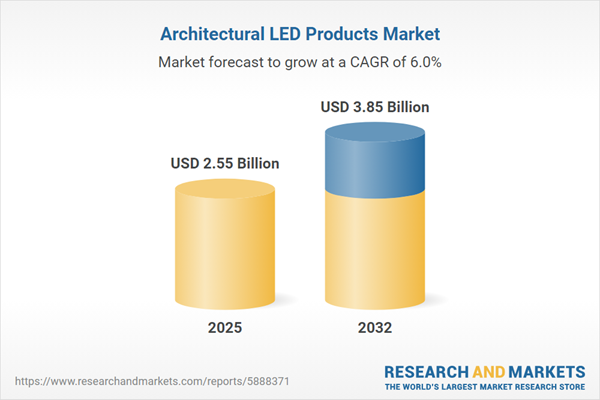Speak directly to the analyst to clarify any post sales queries you may have.
The architectural LED products market is transforming the way commercial, industrial, and public environments approach lighting. Advancements in efficiency, smart integration, and sustainability requirements are reshaping procurement strategies and solution design for industry leaders.
Market Snapshot: Architectural LED Products Market Growth and Dynamics
The Architectural LED Products Market grew from USD 2.41 billion in 2024 to USD 2.55 billion in 2025. This sector is projected to maintain robust momentum, forecast to reach USD 3.85 billion by 2032 at a CAGR of 6.02%.
Scope & Segmentation of the Architectural LED Products Market
This report comprehensively explores the evolving landscape for architectural LED products. It delves into critical segmentation dimensions and regional variance, providing industry leaders with actionable intelligence:
- Product Types: Downlights (covering thresholds from less than 15W to above 30W), Flood Lights (across <50W, 50–100W, and >100W), Linear Lights (spanning <30W to >60W), Panel Lights (<20W, 20–50W, >50W), and Street Lights (<100W, 100–200W, >200W).
- Applications: Commercial settings including hospitality, offices, and retail; industrial scenarios spanning manufacturing and warehouse sites; outdoor spaces for landscape, parking lots, and sports facilities; residential indoor and outdoor projects.
- End Uses: Commercial, industrial, institutional, and residential, each requiring tailored features and procurement methods.
- Distribution Channels: Direct sales, traditional distributors, online platforms, and brick-and-mortar retailers, each with distinct buying cycles and service needs.
- Key Regions: Americas (North and Latin America), Europe, Middle East & Africa, and Asia-Pacific, with in-depth breakdowns for major sub-segments in each area.
- Leading Companies: Signify N.V., Acuity Brands, Inc., OSRAM Licht AG, Eaton Corporation plc, Zumtobel Group AG, Panasonic Corporation, Hubbell Incorporated, Ledvance GmbH, Cree, Inc., and GE Lighting, LLC.
Integration of Advanced Technologies
- Technology Utilization: LED solutions now feature adaptive color tuning, digital controls, IoT connectivity, and performance analytics, becoming central to intelligent building systems.
- Material & Design Innovations: Use of advanced phosphor blends and heat-dissipation alloys enhances both output and longevity, supporting evolving sustainability standards.
Key Takeaways: Strategic Insights for Decision-Makers
- Smart lighting systems are increasingly integral to facility management, supporting data-driven performance optimization and adaptive environments.
- Regulatory focus on energy efficiency and sustainability is catalyzing rapid technology refresh cycles and material innovation across the value chain.
- Market participants adopting modular product designs and plug-and-play solutions are achieving greater customization and faster deployment for diverse end-use cases.
- Adherence to circular economy principles, with initiatives on recycling and reusable components, is strengthening value propositions and aligning brands with client priorities.
- Regional differentiation necessitates local market strategies that account for infrastructure stimulus, certification requirements, and varying urbanization trajectories.
- Collaborative partnerships across technology providers, material scientists, and value-added distributors are pivotal for rapid innovation and market reach.
Tariff Impact & Supply Chain Resilience
- Tariff adjustments in the United States have increased material costs for imported architectural LED components, placing pressure on margin management for non-domestic producers.
- Vertical integration, nearshoring, and dual-sourcing arrangements are being emphasized to safeguard pricing, sustain lead times, and reinforce logistical agility.
- Domestic manufacturing incentives and enhanced logistics collaboration are supporting supply chain resilience amidst ongoing market uncertainty.
Methodology & Data Sources
This research integrates exhaustive secondary reviews of trade literature, regulatory filings, and academic publications with in-depth primary interviews and quantitative surveys. Findings are corroborated via triangulation and benchmarked with recognized analytical tools, ensuring reliable and actionable outcomes.
Why This Report Matters
- Provides grounded, executive-level insights into market developments, supply chain pressures, and technology trends shaping long-term strategy.
- Enables precise targeting and opportunity assessment through granular segmentation by product type, application, end use, and distribution channel.
- Supports resilient decision-making by offering a clear perspective on regional risks, competitive strategies, and regulatory changes.
Conclusion
The architectural LED products market offers new opportunities for leaders focused on innovation, compliance, and operational flexibility. Aligning strategies with technology, sustainability, and evolving regional dynamics will be key to continued advancement and market leadership.
Additional Product Information:
- Purchase of this report includes 1 year online access with quarterly updates.
- This report can be updated on request. Please contact our Customer Experience team using the Ask a Question widget on our website.
Table of Contents
3. Executive Summary
4. Market Overview
7. Cumulative Impact of Artificial Intelligence 2025
Companies Mentioned
The companies profiled in this Architectural LED Products market report include:- Signify N.V.
- Acuity Brands, Inc.
- OSRAM Licht AG
- Eaton Corporation plc
- Zumtobel Group AG
- Panasonic Corporation
- Hubbell Incorporated
- Ledvance GmbH
- Cree, Inc.
- GE Lighting, LLC
Table Information
| Report Attribute | Details |
|---|---|
| No. of Pages | 186 |
| Published | October 2025 |
| Forecast Period | 2025 - 2032 |
| Estimated Market Value ( USD | $ 2.55 Billion |
| Forecasted Market Value ( USD | $ 3.85 Billion |
| Compound Annual Growth Rate | 6.0% |
| Regions Covered | Global |
| No. of Companies Mentioned | 11 |









